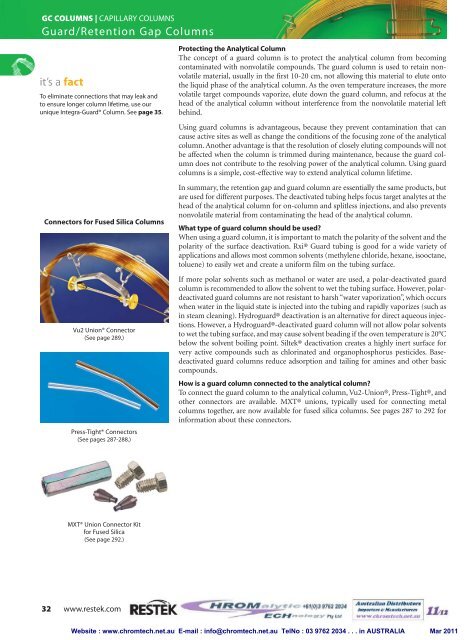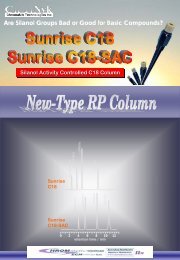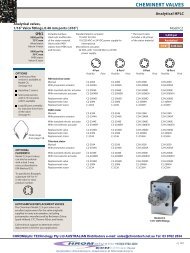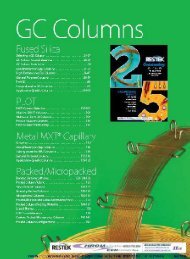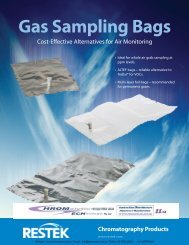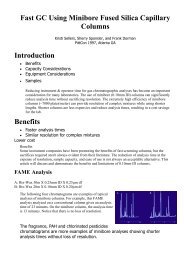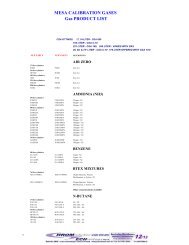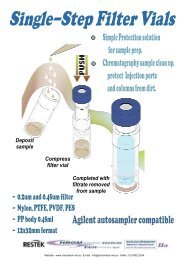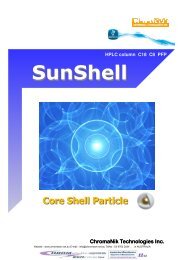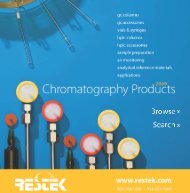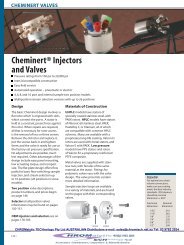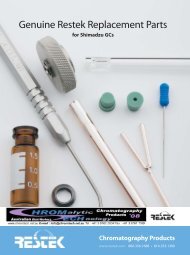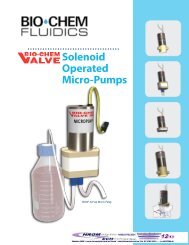Create successful ePaper yourself
Turn your PDF publications into a flip-book with our unique Google optimized e-Paper software.
GC COLUMNS | CAPILLARY COLUMNS<br />
Guard/Retention Gap Columns<br />
it’s a fact<br />
To eliminate connections that may leak and<br />
to ensure longer column lifetime, use our<br />
unique Integra-Guard® Column. See page 35.<br />
Protecting the Analytical Column<br />
The concept of a guard column is to protect the analytical column from becoming<br />
contaminated with nonvolatile compounds. The guard column is used to retain nonvolatile<br />
material, usually in the first 10-20 cm, not allowing this material to elute onto<br />
the liquid phase of the analytical column. As the oven temperature increases, the more<br />
volatile target compounds vaporize, elute down the guard column, and refocus at the<br />
head of the analytical column without interference from the nonvolatile material left<br />
behind.<br />
Using guard <strong>columns</strong> is advantageous, because they prevent contamination that can<br />
cause active sites as well as change the conditions of the focusing zone of the analytical<br />
column. Another advantage is that the resolution of closely eluting compounds will not<br />
be affected when the column is trimmed during maintenance, because the guard column<br />
does not contribute to the resolving power of the analytical column. Using guard<br />
<strong>columns</strong> is a simple, cost-effective way to extend analytical column lifetime.<br />
Connectors for Fused Silica Columns<br />
Vu2 Union® Connector<br />
(See page 289.)<br />
Press-Tight® Connectors<br />
(See pages 287-288.)<br />
In summary, the retention gap and guard column are essentially the same products, but<br />
are used for different purposes. The deactivated tubing helps focus target analytes at the<br />
head of the analytical column for on-column and splitless injections, and also prevents<br />
nonvolatile material from contaminating the head of the analytical column.<br />
What type of guard column should be used<br />
When using a guard column, it is important to match the polarity of the solvent and the<br />
polarity of the surface deactivation. Rxi® Guard tubing is good for a wide variety of<br />
applications and allows most common solvents (methylene chloride, hexane, isooctane,<br />
toluene) to easily wet and create a uniform film on the tubing surface.<br />
If more polar solvents such as methanol or water are used, a polar-deactivated guard<br />
column is recommended to allow the solvent to wet the tubing surface. However, polardeactivated<br />
guard <strong>columns</strong> are not resistant to harsh “water vaporization”, which occurs<br />
when water in the liquid state is injected into the tubing and rapidly vaporizes (such as<br />
in steam cleaning). Hydroguard® deactivation is an alternative for direct aqueous injections.<br />
However, a Hydroguard®-deactivated guard column will not allow polar solvents<br />
to wet the tubing surface, and may cause solvent beading if the oven temperature is 20°C<br />
below the solvent boiling point. Siltek® deactivation creates a highly inert surface for<br />
very active compounds such as chlorinated and organophosphorus pesticides. Basedeactivated<br />
guard <strong>columns</strong> reduce adsorption and tailing for amines and other basic<br />
compounds.<br />
How is a guard column connected to the analytical column<br />
To connect the guard column to the analytical column, Vu2-Union®, Press-Tight®, and<br />
other connectors are available. MXT® unions, typically used for connecting metal<br />
<strong>columns</strong> together, are now available for fused silica <strong>columns</strong>. See pages 287 to 292 for<br />
information about these connectors.<br />
MXT® Union Connector Kit<br />
for Fused Silica<br />
(See page 292.)<br />
32 www.restek.com<br />
Website : www.chromtech.net.au E-mail : info@chromtech.net.au TelNo : 03 9762 2034 . . . in AUSTRALIA Mar 2011


